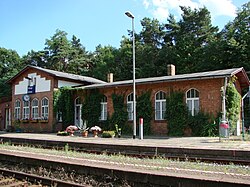
Cottbus or Chóśebuz is a university city and the second-largest city in the German state of Brandenburg after the state capital of Potsdam. With around 98,000 inhabitants, it is the most populous city in Lusatia. Cottbus lies in the Sorbian settlement area of Lower Lusatia, and is the second-largest city on the River Spree after Berlin, which is situated around 125 km (78 mi) upstream. The city is located on the shores of Cottbus Eastern Lake, which will be Germany's largest artificial lake by surface area when flooding is completed.

Lusatia is a historical region in Central Europe, territorially split between Germany and modern-day Poland. Lusatia stretches from the Bóbr and Kwisa rivers in the east to the Pulsnitz and Black Elster rivers in the west, and is located within the German states of Saxony and Brandenburg as well as in the Polish voivodeships of Lower Silesia and Lubusz. Major rivers of Lusatia are the Spree and the Lusatian Neisse, which defines the border between Germany and Poland. The Lusatian Mountains of the Western Sudetes separate Lusatia from Bohemia in the south. Lusatia is traditionally divided into Upper Lusatia, the hilly southern part, and Lower Lusatia, the flat northern part.
Lower Sorbian is a West Slavic minority language spoken in eastern Germany in the historical province of Lower Lusatia, today part of Brandenburg.

Lübbenau is a town in the Upper Spree Forest-Lusatia District of Brandenburg, Germany. It is located in the bilingual German/Sorbian region of (Lower) Lusatia, on the river Spree, where this forms a large inland delta surrounded by woodland, called "Spree Forest", about 82 km (51 mi) southeast of Berlin. The town is best known through the incorporated villages of Lehde/Lědy and Leipe/Lipje, villages where there just exist anabranches of the Spree River instead of streets.

Lower Lusatia is a historical region in Central Europe, stretching from the southeast of the German state of Brandenburg to the southwest of Lubusz Voivodeship in Poland. Like adjacent Upper Lusatia in the south, Lower Lusatia is a settlement area of the West Slavic Sorbs whose endangered Lower Sorbian language is related to Upper Sorbian and Polish.

Forst (Lausitz) (German) or Baršć (Łužyca) (Lower Sorbian, pronounced[ˈbarɕtɕˈwuʒɨtsa]) is a town in Lower Lusatia, Brandenburg, in eastern Germany. It lies east of Cottbus, on the Lusatian Neisse river which is also the German-Polish border. It is the capital of the Spree-Neiße district. It is known for its rose garden and textile museum. The town's population is 18,651. In Forst, there is a railway bridge across the Neiße belonging to the line Cottbus–Żary which is serviced by regional trains and a EuroCity train between Hamburg and Kraków (2011). There is also a road bridge across the river north of Forst.

Jänschwalde is a municipality in the district of Spree-Neiße in Brandenburg, Germany. It is situated in the region of Lower Lusatia. The nearest town is Peitz; Cottbus is 25 km away.
The Lusatian Alliance, formerly the Wendish People's Party is a political party founded on 26 March 2005 in Cottbus to represent the Sorb/Wendish ethnic and linguistic minority in the German states of Saxony and Brandenburg in the region of Lusatia. At its third party congress of 26 April 2010 in Cottbus, the party changed its name to the Lusatian Alliance. The party is a full member of the European Free Alliance.

Döbern is a town in the district of Spree-Neiße, in Lower Lusatia, Brandenburg, Germany. It is situated 25 km southeast of Cottbus, and 15 km south of Forst (Lausitz).
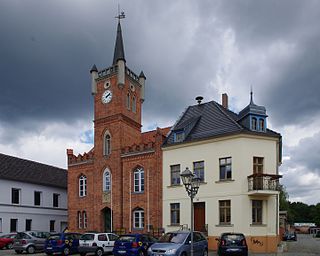
Drebkau is a town in the district of Spree-Neiße, in Lower Lusatia, in Brandenburg, in eastern Germany. It is situated 14 km (9 mi) southwest of Cottbus.
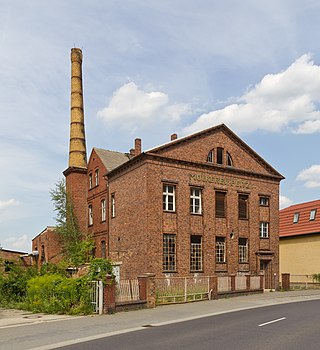
Peitz is a town in the district of Spree-Neiße, in Lower Lusatia, Brandenburg, Germany.

Vetschau/Spreewald is a town in the Oberspreewald-Lausitz district, in Lower Lusatia, Brandenburg, Germany. It is situated in the Spreewald, 18 km west of Cottbus.

Altdöbern is a municipality in the Oberspreewald-Lausitz district, in southern Brandenburg, Germany.
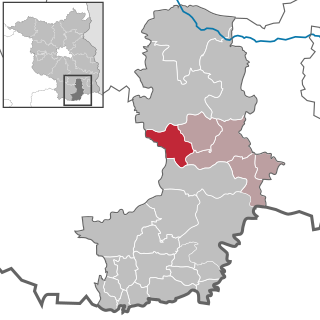
Bronkow is a municipality in the Oberspreewald-Lausitz district, in southern Brandenburg, Germany.

Neuhausen/Spree is a municipality in the district of Spree-Neiße, in Lower Lusatia, Brandenburg, Germany.
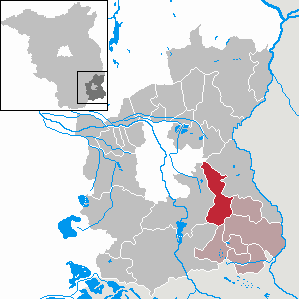
Wiesengrund is a municipality in the district of Spree-Neiße, in Lower Lusatia, Brandenburg, Germany.
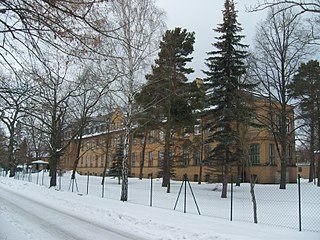
Klettwitz is a village in the municipality of Schipkau, in Brandenburg, in eastern Germany, situated in the historical region of Lower Lusatia.

Cottbus Hauptbahnhof (German) or Chóśebuz głowne dwórnišćo is one of the main railway stations of the German state of Brandenburg. It was called Cottbus station until 9 December 2018. It is located just south of central Cottbus. It is classified by Deutsche Bahn as a Category 2 station.

Lower Sorbian Gymnasium Cottbus, is a coeducational gymnasium in Cottbus the second-largest city in Brandenburg, Germany. It is the only high school in Lower Lusatia in which education is organized in Lower Sorbian language and the language is compulsory up to the twelfth grade. While German language is widely used as the first language by many students and professors, in May 2005 and following the 2004 enlargement of the European Union some students recognized education in the school as a good preparation for future participation in economic exchanges with neighboring West Slavic countries of Czech Republic and Poland.

The Sorbian settlement area commonly makes reference to the area in the east of Saxony and the South of Brandenburg in which the West Slavic people of the Sorbs live autochthonously. In colloquial German, it is called Sorbenland ; before 1945 also – sometimes pejoratively – called Wendei.
